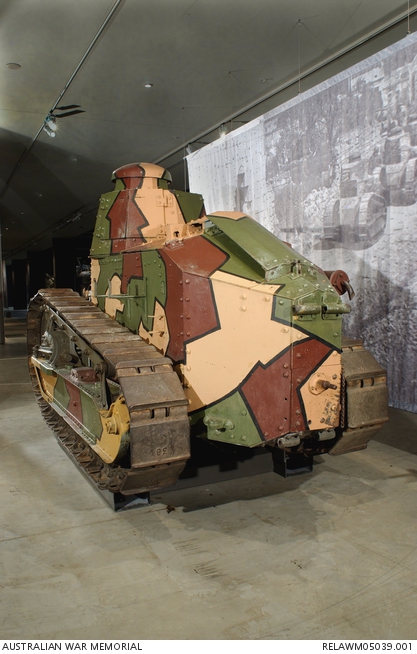| Place | Europe: Western Front |
|---|---|
| Accession Number | RELAWM05039.001 |
| Collection type | Technology |
| Object type | Vehicle |
| Physical description | Steel, Wood |
| Maker |
Renault |
| Place made | France |
| Date made | 1918 |
| Conflict |
First World War, 1914-1918 |
Renault FT Light Tank


Light two man tank with rivetted flat armoured plates. It has a fully rotating, manually operated, one man turret which has been fitted with an 8mm Hotchkiss machine gun.
This turret is the first main production 'Berliet' omnibus type, constructed from flat plate armor. There are split access hatches for the commander fitted in the rear of the turret. The commander either stands within the turret or can be seated on a (missing) canvas sling. There is a commander's cupola fitted to the roof of the turret. The driver sits on a cushion fitted to the floor of the vehicle with a sling back (missing) and his entry point is through split hatches fitted into the front hull glacis. The driver also has a hinging visor which can be raised to assist visability. Steering is by hand levers, brakes and clutch.
The tracks are all steel and coil springs are fitted to the front sides of the vehicle which assist in keeping the tracks tensioned. The running gear consists of six return rollers and nine road wheels fitted to each side. The road wheels are mounted into three paired bogie sets and one triplet. This triplet bogie is the first bogie fitted and is next to the front idler wheel. The large front idler wheel is steel rimmed and made up from laminated timber segments. The steel drive sprocket is mounted at the rear. The four cylinder, liquid cooled petrol engine is fitted at the rear and develops thirty five horse power. It has a cone clutch and a four speed Renault gearbox with one reverse gear. The exhaust system is mounted on the starboard side towards the rear of the vehicle and consists of a cylindrical muffler and short piece of offset exhaust pipe. The muffler has corroded on its lower side. This vehicle is missing the crew compartment floor, which leaves the engine and gear box connecting cables exposed. It is also missing its internal ammunition stowage.
The vehicle's radiator apprears to have been been penetrated by a large calibre shot. Evidence of damage is also visible inside the driver's compartment on the upper left hand side.
The vehicle's exterior bears no visible identification markings. However, on the lower port side running gear girder, telegraphing through the paint scheme, may be seen what appears to be ' Australian War Museum Melbourne'. This references the location to which the tank was originally sent in the early 1920s. The large oval brass manufacturer's plate which would have been mounted on the girder is missing.
A small stamped tally plate is soldered to the uppermost part of the bulkhead separating the crew compartment from the engine compartment. On this is stamped: Chars 1010.
The vehicle wears a light blue grey overall undercoat. It is believed that the vehilce was delivered to Australia in this scheme. The vehicle has been overpainted post-war in the late 1918 French three colour disruptive camouflage scheme of yellow, green and brown with each color separated by a thin black outline.
The French 'Char Renault' (referred to during the war as the Renault FT, and generally post-war as the FT 17) is widely regarded as the first tank to display modern tank qualities such as a fully rotating, 360 degree turret mounting a commander's cupola, a separate engine compartment to the crew compartment and the capability of fitting larger weapons and a future wireless set. It had very good cross country and vertical climbing performance.
This particular vehicle was transported to Australia in the early 1920s as a gift from a grateful French Government. The exact nature of the vehicle's service on the Western front is currently unknown. However, it clearly suffered major incapacitating battle damage.
The manufacturer's factory number '1010' corresponds to a mid-production run Renault-manufactured tank (as opposed to one produced by Schneider/Somua, Delaunay-Bellville or Berliet). Note No. 410 836 1/SA from the Ministry of Armaments and War Manufacturing/Automotive Service Management/Equipment from 1st October 1917 states that the tanks were then given an official 5 digit acceptance number. Renault tanks were given numbers from 66001 to 68999. Under this system, Tank number 1010 corresponds to number 67010. This number would have been painted on the running gear of the tank.